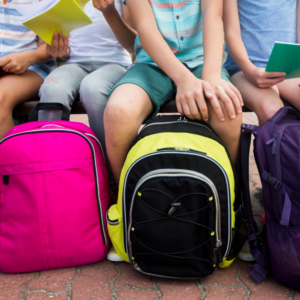This blog article was first published in April 2020. We have updated the content and provided more resources for further learning.
When facing a crisis or turmoil, kids need help from loving adults more than ever.
 A lack of control, a lack of normalcy, and feelings of uncertainty can throw their brains into survival mode, which is the “fight or flight” mode. If their brain is worried about the basic need of survival being met, then it’s not ready to be in learning mode.
A lack of control, a lack of normalcy, and feelings of uncertainty can throw their brains into survival mode, which is the “fight or flight” mode. If their brain is worried about the basic need of survival being met, then it’s not ready to be in learning mode.
Feeling safe and emotionally secure are foundations for emotional, social, and cognitive brain development. To help meet students’ social-emotional needs during a time of crisis, we need to focus on three important aspects of Social-Emotional Learning (SEL): a feeling of safety, connection, and emotional regulation.
Restoring children’s sense of safety can help bring their brains and emotions back in balance.
Tips to provide safety for students at home
1. Routines
Consistent routines and procedures can help reduce stress and facilitate stronger learning for kids during a time of crisis. Try to provide normalcy and create a safe structure and routines for students at home.
2. Psychological distancing
It can feel unsafe for children to talk about how they’re feeling in difficult times. If a child is hesitant to talk about their own feelings, try to use psychological distancing and instead of asking how they specifically are feeling. Ask something a bit more distant like, “What would you do to support your best friend who was telling you they were really worried about their grandma? What would you say to them?” This takes some pressure off because it’s not their emotions to start, but it can move more into a conversation about their emotions.
3. Real talk
Have some real talk with your student about the situation they are facing. Answer questions and share information in a way that a child would understand. Let them know they are safe and that it’s okay to feel upset if they are feeling that way.
4. Share your feelings
Model emotional regulation for your child. You can share with them your emotions and how you’re dealing with those feelings. What makes you hopeful? What makes you feel positive when you’re worried or stressed? This will help students feel safe to share how they’re feeling with a parent or other adult.
5. Limit news and media
Limit the exposure to news coverage, including social media. Kids can easily misinterpret things and become even more anxious if they don’t understand something they heard, read, or saw. While it’s important to talk to students about what’s going on and stay up to date, it’s also important not to overwhelm them and constantly have news broadcasts playing in the background all the time.
Children’s sense of community can quickly get lost during a crisis. It’s important for students to not feel alone. Focusing on creating connections for students.
Tips to create connection for students
1. Continue SEL and community-building practices
Make time for verbal or written “check-ins” with the class and at home.
2. Check-in with family and loved ones
Staying connected to loved ones can help children feel less lonely and isolated. Ways to connect to long-distance loved ones include phone calls, Emails, Mailing letters or postcards, Video chat, sending gifts, or downloading some app-based communication methods.
3. Commit acts of service and kindness
This helps students build an appreciation for their own situation, improve mental health, and allows them to have a connection with other people. Find ways to donate to organizations or people in need, call a neighbor who is alone to give them some company. Things like that demonstrate kindness and help build gratitude during tough times.
It’s important to know that stress changes our brains and behaviors, which makes emotional regulation really difficult.
Strategies to promote emotional regulation
 1. Acknowledge and share feelings
1. Acknowledge and share feelings
Keep in mind that adults may also be in a place of dysregulation. It’s important to acknowledge that both students and parents feel worried or stressed. It’s okay to share that. Talk about that together. Allow students to share and process their emotions, as well as giving them individual time to reflect and gather their thoughts. Within this, the adult should share strategies that they use when they’re stressed to move into a more regulated, balanced place.
2. Celebrate
Try to get up every day with a sense of gratitude and positivity. It can be hard, but really be intentional about finding something small to celebrate each day. Celebrate your health, if the sun is shining, or just the roof over your head. Students can even journal three highlights of the day and share them during dinner or another time together. Research shows that when we appreciate our present status and think of those good things, we develop resilience to the negative events that may be happening in our lives.
3. Basic needs
Make sure kids get the basics of sleep, nutrition, and exercise. Have a normal bedtime routine, eat healthy meals, and set a time to go outside or have an indoor exercise at the same time each day. Physical health is tied to mental health, so try to make sure these basic needs are met for kids at home.
4. Journaling
Teachers or counselors can provide prompts to parents, or students can just keep a journal of how the day went.
5. Find time to breathe or meditate
Make time to pause, breathe, be present, practice gratitude, and destress in a calm way. There are some great meditation apps to download.
 6. Help your child express and name emotions
6. Help your child express and name emotions
This can definitely take practice. One awesome tool for elementary and middle schoolers is the Mood Meter by the RULER at the Yale Center of Emotional Intelligence. For older students, you can do activities where they can practice naming emotions by examining emotional attributes they see in leaders. For younger students, you can read books aloud and then reflect on the feelings of the characters in the books. It helps kids to understand their own emotions when they can name emotions others are having.
Finally, practice some kind of social-emotional learning each day. Families can make these activities part of the daily routine to really support children’s need. Some activities will work for specific students, and some won’t. But be patient and push families to keep trying until they find a strategy that works for that unique child.
Other recommended resources include:
The post Addressing Children’s Social-Emotional Needs During Times of Crisis appeared first on Possip | Engagement Platform | School Feedback Survey.
No comments:
Post a Comment